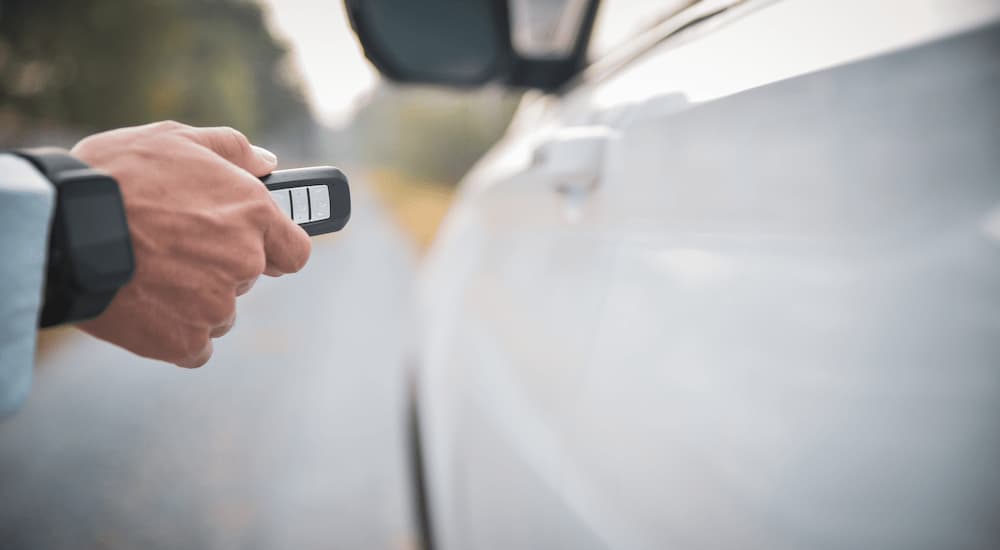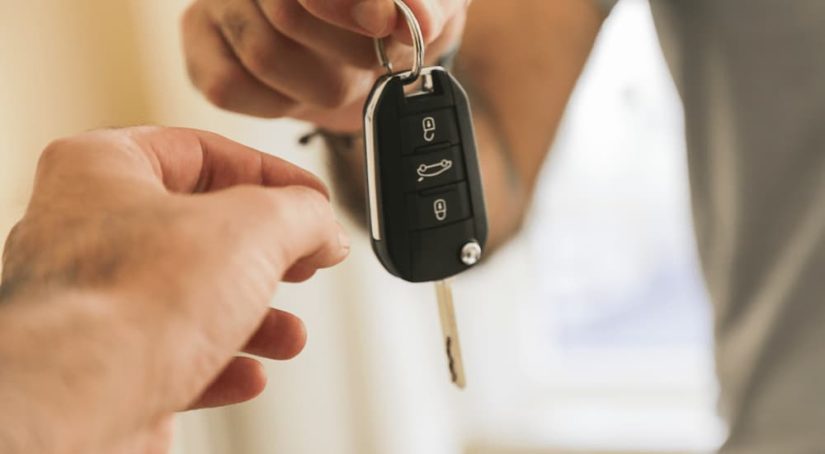Did you know that the first car key was introduced in 1910? Since then, car keys have become an inseparable part of modern life, something that you almost never leave the house without. However, very few modern cars actually come with simple metal keys anymore, and changing technology threatens to eliminate the car key altogether! If you are shopping for a new car to replace a vehicle that you have had for a long time, then you might be surprised to learn all the different options available for unlocking and starting your car. From Keyless Entry to Phone as Key, manufacturers have made living with your car more convenient than ever before, and even more revolutionary technologies might be coming soon.
Remote Keyless Entry and Remote Start
The first step towards improving the car key is one that nearly everyone is familiar with, although you might not be aware of the official terminology. Remote Keyless Entry uses a keyfob with a short-range radio transmitter––press the button on the keyfob to unlock the car, and the car unlocks. Most keyfobs include buttons for locking and unlocking the vehicle, as well as a panic button that sets off the car alarm. A separate button to unlock just the truck is also a common feature.
This system first appeared in the Renault Fuego in 1982, and nearly every modern car comes with some form of Remote Keyless Entry. But while it can be convenient to be able to lock and unlock your car from a distance, this system still has more than its fair share of limitations. The range is limited to just a few yards, you have to pull the keyfob out of your purse or pocket to use it, and you still need the physical key to turn on the car.
Remote Keyless Entry is sometimes paired with Remote Start, which also uses a keyfob with a short-range transmitter. Remote Start can start your car from a distance without having the key in the ignition, but it is meant purely for heating or cooling your car before you get in. Most Remote Start systems still require you to put the key in the ignition before you can actually drive away. While this is a nice upgrade to have if you live in a particularly cold or warm climate, it was still just a step in the evolution of the car key. Interestingly, it took until 2004 before Remote Start was available as a factory option.

Keyless Entry and Push Button Start
The largest drawback to Remote Keyless Entry was that you still needed to dig out your keys to use it. The next step was Keyless Entry. Despite having similar names, Keyless Entry is a large step up from Remote Keyless Entry, as it allows you to simply walk up to your car and open the door without ever touching your keyfob. You still need to have your keyfob with you, as it emits a signal telling your car that it’s okay to unlock the doors, but you can keep it securely in your pocket or purse.
Mercedes was the first manufacturer to introduce Keyless Entry, coming out with the technology in 2003, and most luxury manufacturers quickly followed suit. Today, most models offer Keyless Entry on their top trims, and more and more cars are coming standard with the feature. However, there are a few different variations on it. The most common form of Keyless Entry has a small button on the driver’s door handle. When you want to lock or unlock your car, simply press the button while you have your keyfob with you. A more advanced version eliminates buttons entirely––all you need to do is pull on the door handle, and it will automatically unlock.
Today, Keyless Entry is almost always paired with Push Button Start. Since the amazing convenience of unlocking your car without ever touching your keys would be undermined if you still needed your keys in hand to turn the car on, the two technologies complement each other well. Push Button Start replaces the normal key ignition system with a radio receiver and a button. As long as you have your keyfob with you in the car, all you need to do is press the button, and the vehicle will start. Never again will you have to worry about locking your keys in the car!
Keyless Entry Keypad
One of the earlier attempts at keyless entry was to simply attach a small keypad to the exterior of the vehicle near the driver’s door. The idea was that you could simply punch in your security code and unlock your car without needing to use your keys. Ford was the first manufacturer to introduce this system, unveiling it for the 1980 model year, and still offers it on many models today under the name SecuriCode. While Keyless Entry Keypads have been rendered mostly obsolete by Keyless Entry, some drivers still like to have the option of both systems. Having the keypad available is great if you need to get something out of your car when you’re at home or other times you don’t want to have your keys on you.
Digital Keys and Apps
Keyless and Entry and Push Button Start are extremely convenient, but what if you didn’t need to carry a keyfob with you at all? Well, some cars already give you that option! While the technology hasn’t become mainstream yet, manufacturers have devised several ways to unlock, start, and even drive your car using your phone as your key. Not only does this let you get rid of your keyfob, but using a phone-based app gives you an easier-to-use interface and even more options for controlling your car.
It is little surprise that Tesla was the first brand to abandon the traditional keyfob. The tech-focused brand is never afraid of trying something new, but it still might startle you to learn that its cars don’t come with a traditional key or keyfob of any type! When you buy a Tesla, it only comes with two RFID key cards that look just like something you’d get when you check into a hotel. However, even these are designed as something to give to a family member or valet when they need to drive your car. The real keyfob is the Tesla app on your phone.
Teslas are designed to communicate with your phone using Bluetooth. Once you download the Tesla App, all you need to do to unlock your car is pull on the door handle while you have your phone in your pocket or purse. You can also use the app to remotely unlock, lock, or start your Tesla. Interestingly, Tesla’s App even lets you remotely allow someone else to start your car and drive it without giving them any form of a physical key!

Manufacturer Apps
While Tesla is so far the only manufacturer to entirely abandon the traditional keyfob, other brands aren’t far behind. Virtually every new car sold is compatible with the manufacturer’s smartphone app. These apps will generally allow your phone to function as a keyfob for Remote Keyless Entry and Remote Start, as well as provide additional features like being able to check fuel levels or being alerted if an alarm is triggered. Because your phone and car communicate via the internet when using these features, they do not have the range limits of a traditional keyfob, but they will not work in remote areas without cell service.
Some brands have gone further in mimicking Tesla, particularly Ford and Lincoln, which offer Phone as Key in select models. This use of the FordConnect app allows your car and phone to communicate with Bluetooth, allowing you to unlock and drive without having a traditional keyfob with you. This option will likely become even more common in the coming years as more drivers desire to ditch the traditional keyfob in favor of their phones.
Apple and Google
The next big step in the evolution of the car key appears to be coming with recent announcements from Apple and Google. In June 2020, Apple announced that its Wallet app would be able to store a digital car key, and in May 2021, Google announced Android Digital Car Key. Currently, both of these apps are only compatible with the latest phones and select BMW models, but they have the potential to revolutionize the car key. Just as Android Auto and Apple CarPlay have all but replaced manufacturer-specific infotainment and navigation systems, these new apps may soon replace manufacturer-specific phone apps with an easier-to-use and more universal solution.
Apple and Google have also paired their software improvements with hardware advances that promise to be a superior solution to the current Bluetooth pairing used by Tesla and Ford. By using Near Field Communication (NFC) and Ultra-wideband (UWB) technology, these new apps are far more secure and provide a much more reliable connection. However, very few phones or cars currently have the hardware to support these features, so it will likely be several years before this technology becomes widely available for drivers.
What’s Next for the Car Key?
Technology seems to be improving faster and faster these days, and the simple car key is no exception. Basic metal keys reigned for the better part of a century before Remote Keyless Entry was introduced, but true Keyless Entry appeared only 21 years later, and Tesla shocked the world by getting rid of keys entirely just 15 years after that. Apple and Google’s latest smartphone apps will likely become as universal as Remote Keyless Entry has, but they will probably not be the last improvement when it comes to the car key. The question is, what’s next? Hyundai recently began installing fingerprint scanners in vehicles sold in China, and Apple has patented using its Face ID technology for future cars. With ideas like these, there is a good chance that even digital “keys” will become obsolete in the future.



